Differentiating the Equation Solution 2022
VerifiedAdded on 2022/09/07
|6
|330
|20
AI Summary
Contribute Materials
Your contribution can guide someone’s learning journey. Share your
documents today.
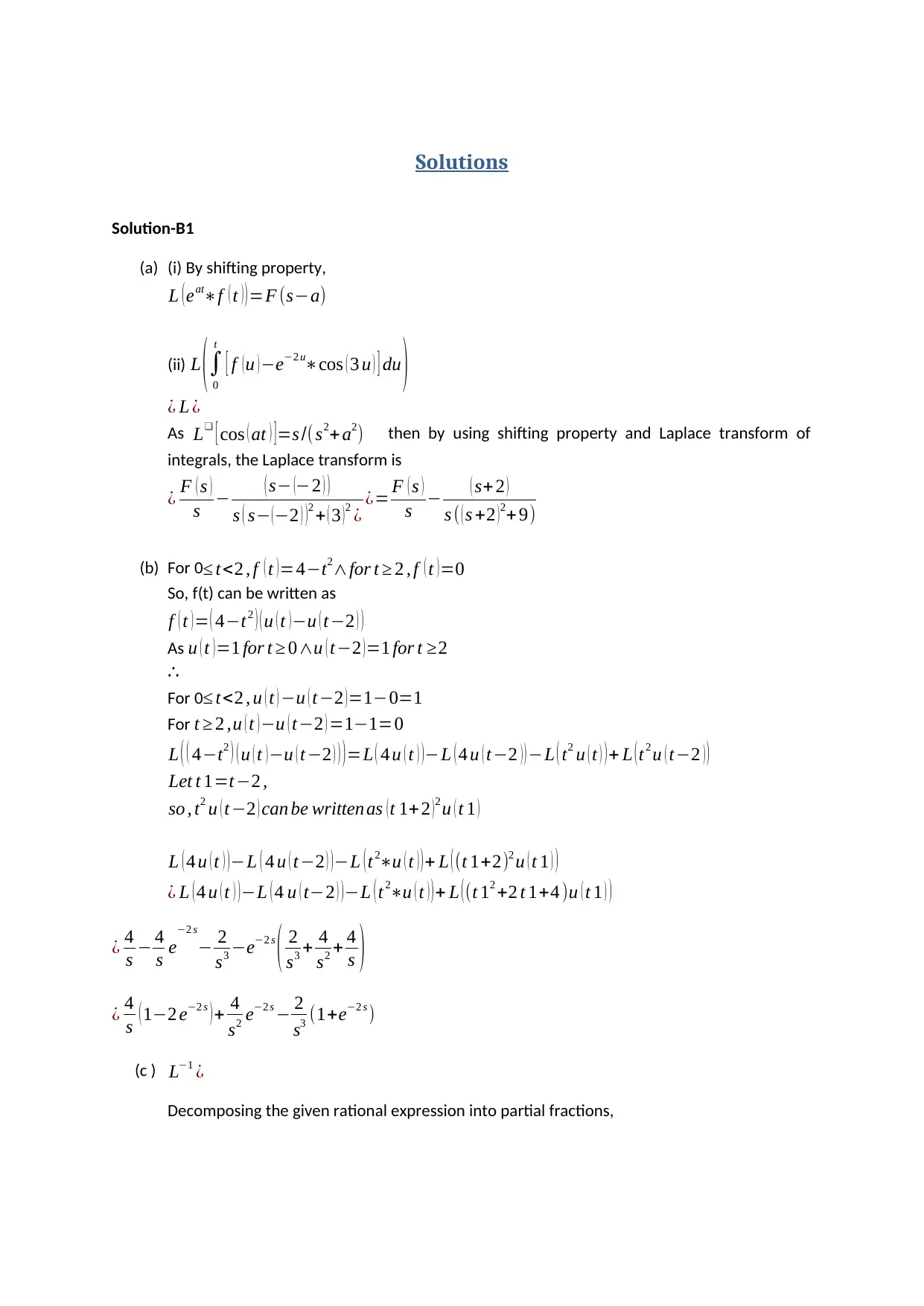
Solutions
Solution-B1
(a) (i) By shifting property,
L (eat∗f ( t ) )=F (s−a)
(ii) L (∫
0
t
[ f (u )−e−2 u∗cos ( 3 u ) ] du )
¿ L ¿
As L❑ [ cos ( at ) ] =s /(s2+ a2) then by using shifting property and Laplace transform of
integrals, the Laplace transform is
¿ F ( s )
s − ( s− (−2 ) )
s ( s− (−2 ) )2 + ( 3 )2 ¿ ¿= F ( s )
s − ( s+ 2 )
s ( ( s +2 )2+ 9)
(b) For 0≤ t<2 , f ( t ) =4−t2∧for t ≥ 2 , f ( t ) =0
So, f(t) can be written as
f ( t )= ( 4−t2 ) ( u ( t )−u ( t−2 ) )
As u ( t )=1 for t ≥ 0∧u ( t−2 )=1 for t ≥2
∴
For 0≤ t<2 , u ( t ) −u ( t−2 )=1−0=1
For t ≥ 2 ,u ( t )−u ( t−2 ) =1−1=0
L ( ( 4−t2 ) ( u ( t ) −u ( t−2 ) ) ) =L ( 4 u ( t ) )−L ( 4 u ( t−2 ) ) −L ( t2 u ( t ) ) + L ( t2 u ( t−2 ) )
Let t 1=t−2 ,
so , t2 u ( t−2 ) can be written as (t 1+2 )2 u ( t 1 )
L ( 4 u ( t ) ) −L ( 4 u ( t−2 ) ) −L ( t 2∗u ( t ) ) + L ( (t 1+2)2 u ( t 1 ) )
¿ L ( 4 u ( t ) )−L ( 4 u ( t−2 ) )−L ( t2∗u ( t ) )+ L ((t 12 +2 t 1+4 )u ( t 1 ) )
¿ 4
s − 4
s e
−2 s
− 2
s3 −e−2 s
( 2
s3 + 4
s2 + 4
s )
¿ 4
s (1−2 e−2 s ) + 4
s2 e−2 s − 2
s3 (1+e−2 s )
(c ) L−1 ¿
Decomposing the given rational expression into partial fractions,
Solution-B1
(a) (i) By shifting property,
L (eat∗f ( t ) )=F (s−a)
(ii) L (∫
0
t
[ f (u )−e−2 u∗cos ( 3 u ) ] du )
¿ L ¿
As L❑ [ cos ( at ) ] =s /(s2+ a2) then by using shifting property and Laplace transform of
integrals, the Laplace transform is
¿ F ( s )
s − ( s− (−2 ) )
s ( s− (−2 ) )2 + ( 3 )2 ¿ ¿= F ( s )
s − ( s+ 2 )
s ( ( s +2 )2+ 9)
(b) For 0≤ t<2 , f ( t ) =4−t2∧for t ≥ 2 , f ( t ) =0
So, f(t) can be written as
f ( t )= ( 4−t2 ) ( u ( t )−u ( t−2 ) )
As u ( t )=1 for t ≥ 0∧u ( t−2 )=1 for t ≥2
∴
For 0≤ t<2 , u ( t ) −u ( t−2 )=1−0=1
For t ≥ 2 ,u ( t )−u ( t−2 ) =1−1=0
L ( ( 4−t2 ) ( u ( t ) −u ( t−2 ) ) ) =L ( 4 u ( t ) )−L ( 4 u ( t−2 ) ) −L ( t2 u ( t ) ) + L ( t2 u ( t−2 ) )
Let t 1=t−2 ,
so , t2 u ( t−2 ) can be written as (t 1+2 )2 u ( t 1 )
L ( 4 u ( t ) ) −L ( 4 u ( t−2 ) ) −L ( t 2∗u ( t ) ) + L ( (t 1+2)2 u ( t 1 ) )
¿ L ( 4 u ( t ) )−L ( 4 u ( t−2 ) )−L ( t2∗u ( t ) )+ L ((t 12 +2 t 1+4 )u ( t 1 ) )
¿ 4
s − 4
s e
−2 s
− 2
s3 −e−2 s
( 2
s3 + 4
s2 + 4
s )
¿ 4
s (1−2 e−2 s ) + 4
s2 e−2 s − 2
s3 (1+e−2 s )
(c ) L−1 ¿
Decomposing the given rational expression into partial fractions,
Secure Best Marks with AI Grader
Need help grading? Try our AI Grader for instant feedback on your assignments.
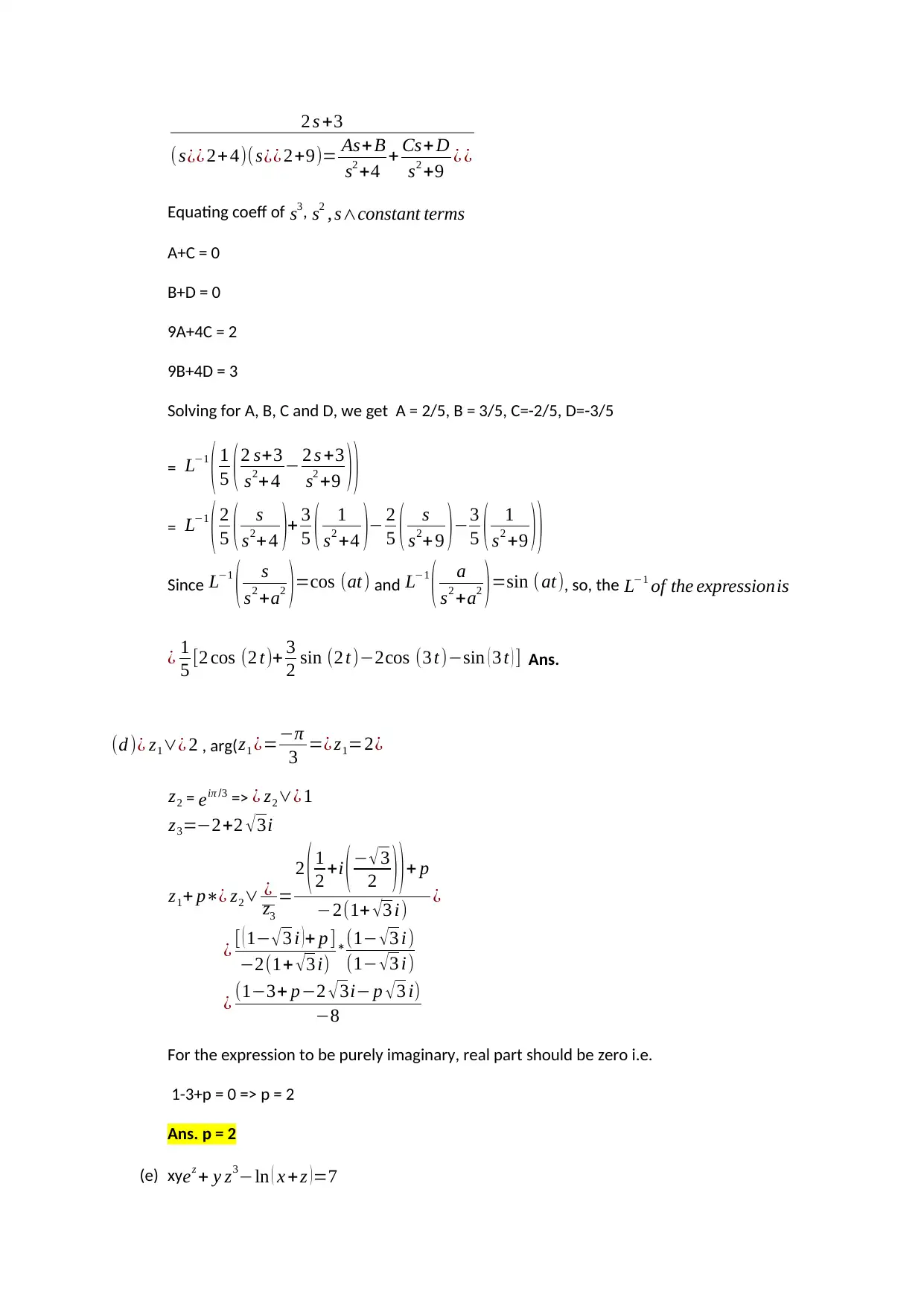
2 s +3
( s¿¿ 2+ 4)(s¿¿ 2+9)= As+ B
s2 +4 + Cs+ D
s2 +9 ¿ ¿
Equating coeff of s3, s2 , s∧constant terms
A+C = 0
B+D = 0
9A+4C = 2
9B+4D = 3
Solving for A, B, C and D, we get A = 2/5, B = 3/5, C=-2/5, D=-3/5
= L−1
( 1
5 (2 s+3
s2+4 − 2 s +3
s2 +9 ) )
= L−1
( 2
5 ( s
s2+4 )+ 3
5 ( 1
s2 +4 )− 2
5 ( s
s2+ 9 )−3
5 ( 1
s2 +9 ) )
Since L−1
( s
s2 +a2 )=cos (at) and L−1
( a
s2 +a2 ) =sin ( at), so, the L−1 of the expressionis
¿ 1
5 [2 cos (2 t)+ 3
2 sin (2 t)−2cos (3 t)−sin ( 3 t ) ] Ans.
(d )¿ z1∨¿ 2 , arg(z1 ¿=−π
3 =¿ z1=2¿
z2 = eiπ /3 => ¿ z2∨¿ 1
z3=−2+2 √3i
z1+ p∗¿ z2∨ ¿
z3
=
2 ( 1
2 +i ( − √ 3
2 ) ) + p
−2(1+ √ 3 i) ¿
¿ [ ( 1− √3 i )+ p ]
−2(1+ √3 i) *(1− √3 i)
(1− √3 i)
¿ (1−3+ p−2 √ 3i− p √ 3 i)
−8
For the expression to be purely imaginary, real part should be zero i.e.
1-3+p = 0 => p = 2
Ans. p = 2
(e) xyez + y z3−ln ( x +z )=7
( s¿¿ 2+ 4)(s¿¿ 2+9)= As+ B
s2 +4 + Cs+ D
s2 +9 ¿ ¿
Equating coeff of s3, s2 , s∧constant terms
A+C = 0
B+D = 0
9A+4C = 2
9B+4D = 3
Solving for A, B, C and D, we get A = 2/5, B = 3/5, C=-2/5, D=-3/5
= L−1
( 1
5 (2 s+3
s2+4 − 2 s +3
s2 +9 ) )
= L−1
( 2
5 ( s
s2+4 )+ 3
5 ( 1
s2 +4 )− 2
5 ( s
s2+ 9 )−3
5 ( 1
s2 +9 ) )
Since L−1
( s
s2 +a2 )=cos (at) and L−1
( a
s2 +a2 ) =sin ( at), so, the L−1 of the expressionis
¿ 1
5 [2 cos (2 t)+ 3
2 sin (2 t)−2cos (3 t)−sin ( 3 t ) ] Ans.
(d )¿ z1∨¿ 2 , arg(z1 ¿=−π
3 =¿ z1=2¿
z2 = eiπ /3 => ¿ z2∨¿ 1
z3=−2+2 √3i
z1+ p∗¿ z2∨ ¿
z3
=
2 ( 1
2 +i ( − √ 3
2 ) ) + p
−2(1+ √ 3 i) ¿
¿ [ ( 1− √3 i )+ p ]
−2(1+ √3 i) *(1− √3 i)
(1− √3 i)
¿ (1−3+ p−2 √ 3i− p √ 3 i)
−8
For the expression to be purely imaginary, real part should be zero i.e.
1-3+p = 0 => p = 2
Ans. p = 2
(e) xyez + y z3−ln ( x +z )=7
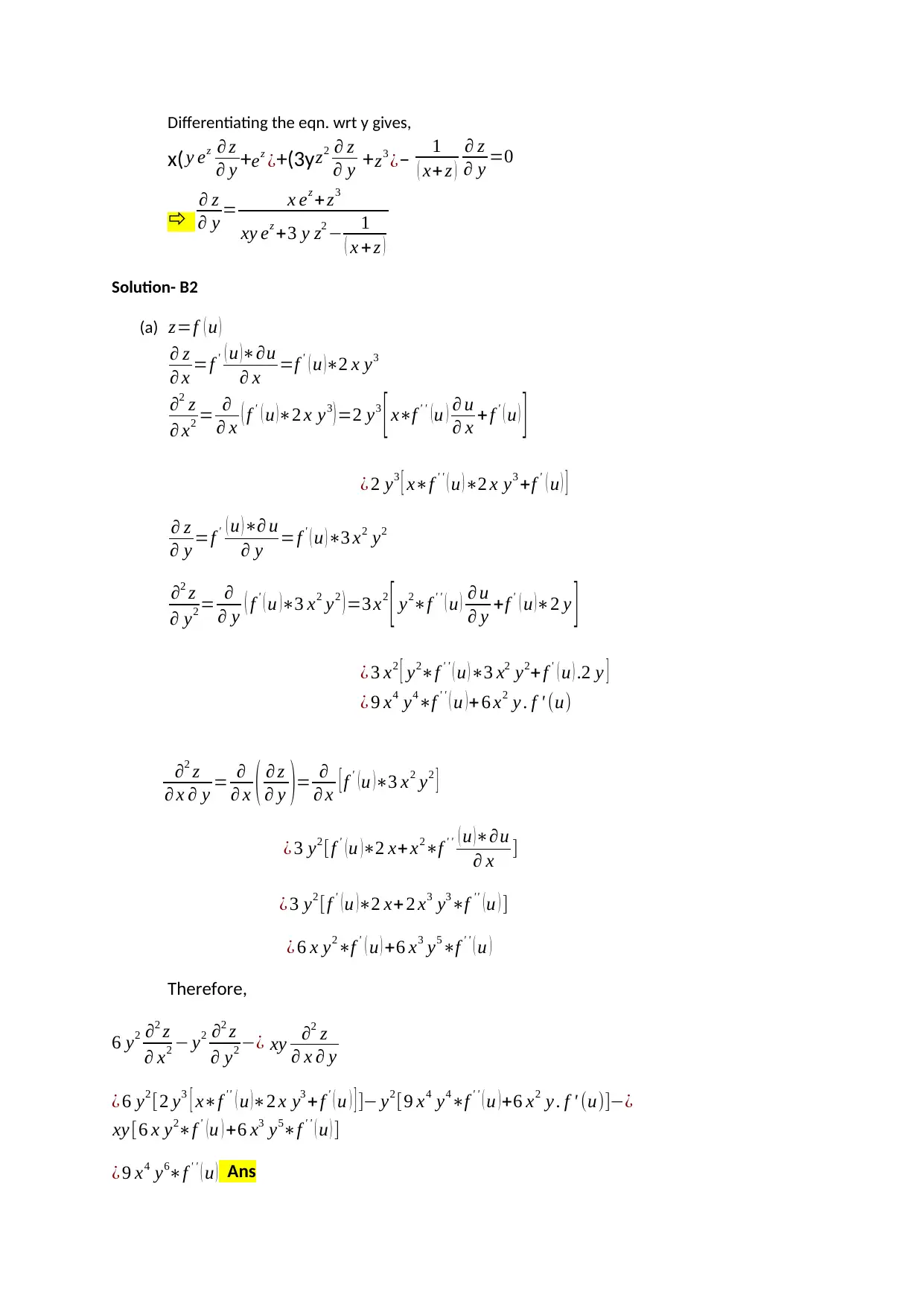
Differentiating the eqn. wrt y gives,
x(y ez ∂ z
∂ y +ez ¿+(3y z2 ∂ z
∂ y + z3 ¿– 1
( x+ z )
∂ z
∂ y =0
∂ z
∂ y = x ez + z3
xy ez +3 y z2 − 1
( x + z )
Solution- B2
(a) z=f ( u )
∂ z
∂ x =f ' ( u )∗∂u
∂ x =f ' ( u )∗2 x y3
∂2 z
∂ x2 = ∂
∂ x ( f ' ( u )∗2 x y3 )=2 y3
[ x∗f ' ' (u ) ∂ u
∂ x + f ' ( u ) ]
¿ 2 y3 [ x∗f ' ' ( u )∗2 x y3 +f ' ( u ) ]
∂ z
∂ y =f ' ( u )∗∂ u
∂ y =f ' ( u )∗3 x2 y2
∂2 z
∂ y2 = ∂
∂ y ( f ' ( u )∗3 x2 y2 )=3 x2
[ y2∗f ' ' ( u ) ∂ u
∂ y +f ' ( u )∗2 y ]
¿ 3 x2 [ y2∗f ' ' ( u )∗3 x2 y2+ f ' ( u ) .2 y ]
¿ 9 x4 y4∗f ' ' ( u ) + 6 x2 y . f ' (u)
∂2 z
∂ x ∂ y = ∂
∂ x ( ∂ z
∂ y )= ∂
∂ x [ f ' ( u )∗3 x2 y2 ]
¿ 3 y2 [f ' ( u )∗2 x+x2∗f ' ' ( u )∗∂u
∂ x ]
¿ 3 y2 [ f ' (u )∗2 x+ 2 x3 y3∗f '' (u ) ]
¿ 6 x y2∗f ' ( u ) +6 x3 y5∗f ' ' ( u )
Therefore,
6 y2 ∂2 z
∂ x2 − y2 ∂2 z
∂ y2 −¿ xy ∂2 z
∂ x ∂ y
¿ 6 y2 [2 y3 [ x∗f ' ' ( u )∗2 x y3 + f ' ( u ) ] ]− y2 [9 x4 y4∗f ' ' ( u ) +6 x2 y . f ' (u)]−¿
xy [6 x y2∗f ' ( u ) +6 x3 y5∗f ' ' ( u ) ]
¿ 9 x4 y6∗f ' ' ( u ) Ans
x(y ez ∂ z
∂ y +ez ¿+(3y z2 ∂ z
∂ y + z3 ¿– 1
( x+ z )
∂ z
∂ y =0
∂ z
∂ y = x ez + z3
xy ez +3 y z2 − 1
( x + z )
Solution- B2
(a) z=f ( u )
∂ z
∂ x =f ' ( u )∗∂u
∂ x =f ' ( u )∗2 x y3
∂2 z
∂ x2 = ∂
∂ x ( f ' ( u )∗2 x y3 )=2 y3
[ x∗f ' ' (u ) ∂ u
∂ x + f ' ( u ) ]
¿ 2 y3 [ x∗f ' ' ( u )∗2 x y3 +f ' ( u ) ]
∂ z
∂ y =f ' ( u )∗∂ u
∂ y =f ' ( u )∗3 x2 y2
∂2 z
∂ y2 = ∂
∂ y ( f ' ( u )∗3 x2 y2 )=3 x2
[ y2∗f ' ' ( u ) ∂ u
∂ y +f ' ( u )∗2 y ]
¿ 3 x2 [ y2∗f ' ' ( u )∗3 x2 y2+ f ' ( u ) .2 y ]
¿ 9 x4 y4∗f ' ' ( u ) + 6 x2 y . f ' (u)
∂2 z
∂ x ∂ y = ∂
∂ x ( ∂ z
∂ y )= ∂
∂ x [ f ' ( u )∗3 x2 y2 ]
¿ 3 y2 [f ' ( u )∗2 x+x2∗f ' ' ( u )∗∂u
∂ x ]
¿ 3 y2 [ f ' (u )∗2 x+ 2 x3 y3∗f '' (u ) ]
¿ 6 x y2∗f ' ( u ) +6 x3 y5∗f ' ' ( u )
Therefore,
6 y2 ∂2 z
∂ x2 − y2 ∂2 z
∂ y2 −¿ xy ∂2 z
∂ x ∂ y
¿ 6 y2 [2 y3 [ x∗f ' ' ( u )∗2 x y3 + f ' ( u ) ] ]− y2 [9 x4 y4∗f ' ' ( u ) +6 x2 y . f ' (u)]−¿
xy [6 x y2∗f ' ( u ) +6 x3 y5∗f ' ' ( u ) ]
¿ 9 x4 y6∗f ' ' ( u ) Ans
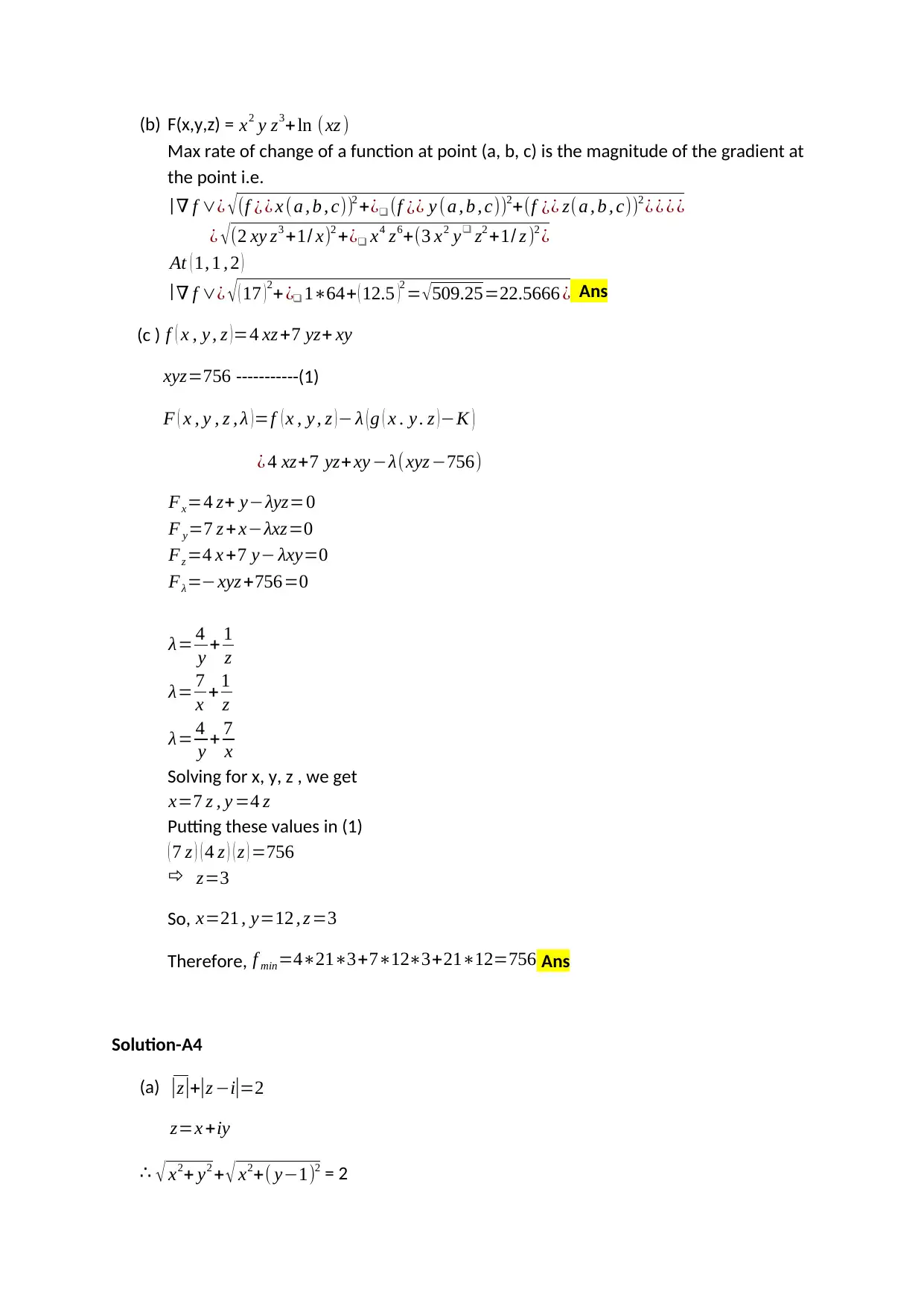
(b) F(x,y,z) = x2 y z3+ln (xz )
Max rate of change of a function at point (a, b, c) is the magnitude of the gradient at
the point i.e.
|∇ f ∨¿ √(f ¿ ¿ x ( a , b , c))2 +¿❑ (f ¿¿ y ( a , b , c))2+(f ¿¿ z(a , b , c))2 ¿ ¿ ¿ ¿
¿ √ (2 xy z3 +1/ x)2 +¿❑ x4 z6+(3 x2 y❑ z2 +1/ z )2 ¿
At ( 1, 1 , 2 )
|∇ f ∨¿ √ ( 17 )2+ ¿❑ 1∗64+ ( 12.5 )2 = √509.25=22.5666 ¿ Ans
(c ) f ( x , y , z ) =4 xz +7 yz+ xy
xyz=756 -----------(1)
F ( x , y , z , λ )=f ( x , y , z )− λ ( g ( x . y . z )−K )
¿ 4 xz+7 yz+ xy −λ(xyz −756)
Fx=4 z+ y−λyz=0
F y=7 z + x−λxz=0
Fz =4 x +7 y− λxy=0
Fλ=−xyz +756=0
λ= 4
y + 1
z
λ= 7
x + 1
z
λ= 4
y + 7
x
Solving for x, y, z , we get
x=7 z , y =4 z
Putting these values in (1)
( 7 z ) ( 4 z ) ( z ) =756
z=3
So, x=21 , y=12 , z =3
Therefore, f min=4∗21∗3+7∗12∗3+21∗12=756 Ans
Solution-A4
(a) |z|+|z −i|=2
z=x +iy
∴ √ x2+ y2 + √ x2+( y−1)2 = 2
Max rate of change of a function at point (a, b, c) is the magnitude of the gradient at
the point i.e.
|∇ f ∨¿ √(f ¿ ¿ x ( a , b , c))2 +¿❑ (f ¿¿ y ( a , b , c))2+(f ¿¿ z(a , b , c))2 ¿ ¿ ¿ ¿
¿ √ (2 xy z3 +1/ x)2 +¿❑ x4 z6+(3 x2 y❑ z2 +1/ z )2 ¿
At ( 1, 1 , 2 )
|∇ f ∨¿ √ ( 17 )2+ ¿❑ 1∗64+ ( 12.5 )2 = √509.25=22.5666 ¿ Ans
(c ) f ( x , y , z ) =4 xz +7 yz+ xy
xyz=756 -----------(1)
F ( x , y , z , λ )=f ( x , y , z )− λ ( g ( x . y . z )−K )
¿ 4 xz+7 yz+ xy −λ(xyz −756)
Fx=4 z+ y−λyz=0
F y=7 z + x−λxz=0
Fz =4 x +7 y− λxy=0
Fλ=−xyz +756=0
λ= 4
y + 1
z
λ= 7
x + 1
z
λ= 4
y + 7
x
Solving for x, y, z , we get
x=7 z , y =4 z
Putting these values in (1)
( 7 z ) ( 4 z ) ( z ) =756
z=3
So, x=21 , y=12 , z =3
Therefore, f min=4∗21∗3+7∗12∗3+21∗12=756 Ans
Solution-A4
(a) |z|+|z −i|=2
z=x +iy
∴ √ x2+ y2 + √ x2+( y−1)2 = 2
Secure Best Marks with AI Grader
Need help grading? Try our AI Grader for instant feedback on your assignments.
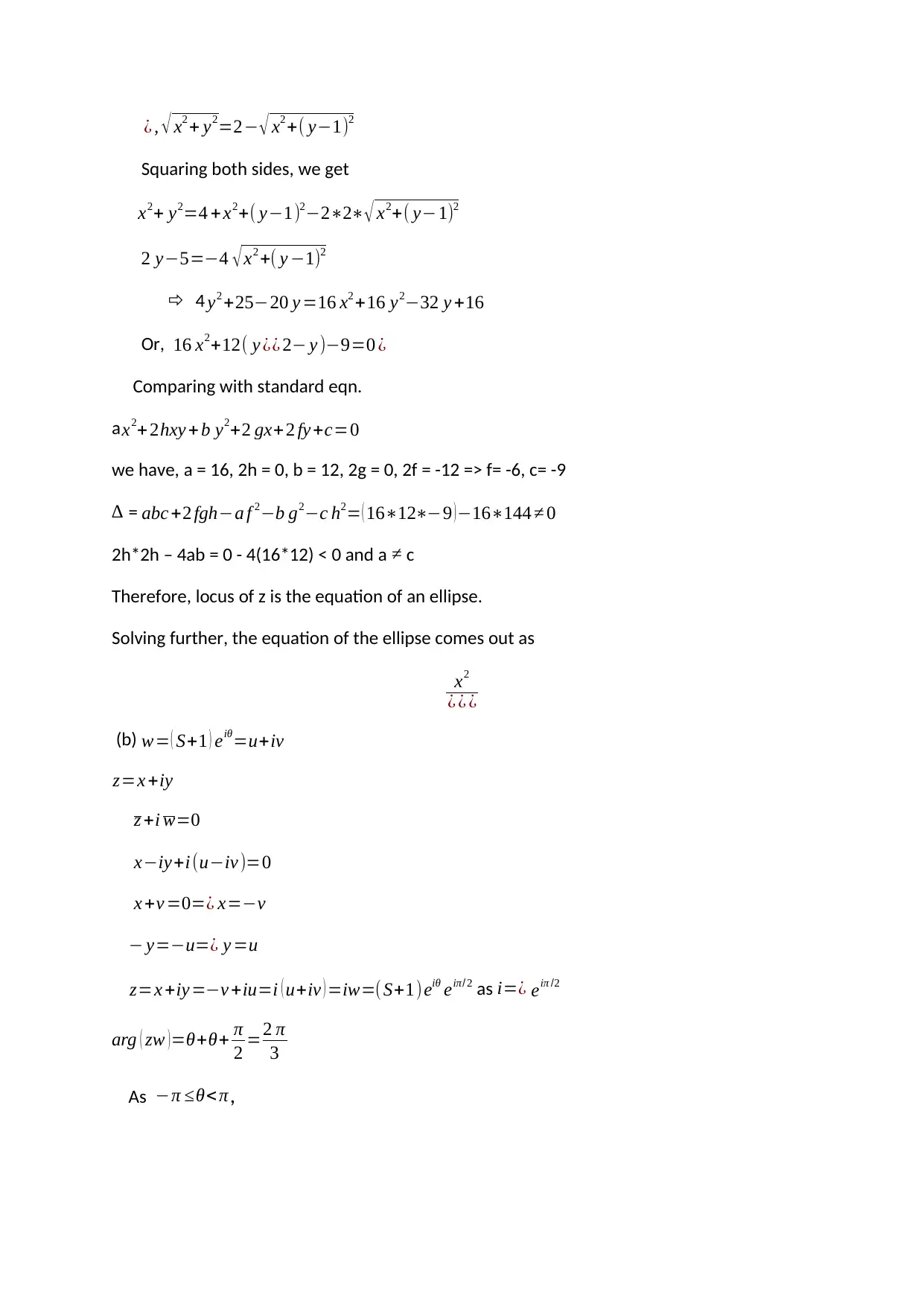
¿ , √ x2 + y2=2− √ x2 +( y−1)2
Squaring both sides, we get
x2+ y2=4 + x2+( y−1)2−2∗2∗√ x2+( y−1)2
2 y−5=−4 √ x2 +( y −1)2
4 y2 +25−20 y =16 x2 +16 y2−32 y +16
Or, 16 x2+12( y ¿¿ 2− y )−9=0 ¿
Comparing with standard eqn.
a x2+2hxy + b y2+2 gx+ 2 fy +c=0
we have, a = 16, 2h = 0, b = 12, 2g = 0, 2f = -12 => f= -6, c= -9
∆ = abc +2 fgh−a f 2−b g2−c h2= ( 16∗12∗−9 )−16∗144 ≠ 0
2h*2h – 4ab = 0 - 4(16*12) < 0 and a ≠ c
Therefore, locus of z is the equation of an ellipse.
Solving further, the equation of the ellipse comes out as
x2
¿ ¿ ¿
(b) w= ( S+1 ) eiθ=u+iv
z=x +iy
z +i w=0
x−iy+i(u−iv)=0
x +v =0=¿ x=−v
− y=−u=¿ y =u
z=x +iy=−v +iu=i ( u+iv ) =iw=( S+1)eiθ eiπ/ 2 as i=¿ eiπ /2
arg ( zw )=θ+θ+ π
2 =2 π
3
As −π ≤θ< π,
Squaring both sides, we get
x2+ y2=4 + x2+( y−1)2−2∗2∗√ x2+( y−1)2
2 y−5=−4 √ x2 +( y −1)2
4 y2 +25−20 y =16 x2 +16 y2−32 y +16
Or, 16 x2+12( y ¿¿ 2− y )−9=0 ¿
Comparing with standard eqn.
a x2+2hxy + b y2+2 gx+ 2 fy +c=0
we have, a = 16, 2h = 0, b = 12, 2g = 0, 2f = -12 => f= -6, c= -9
∆ = abc +2 fgh−a f 2−b g2−c h2= ( 16∗12∗−9 )−16∗144 ≠ 0
2h*2h – 4ab = 0 - 4(16*12) < 0 and a ≠ c
Therefore, locus of z is the equation of an ellipse.
Solving further, the equation of the ellipse comes out as
x2
¿ ¿ ¿
(b) w= ( S+1 ) eiθ=u+iv
z=x +iy
z +i w=0
x−iy+i(u−iv)=0
x +v =0=¿ x=−v
− y=−u=¿ y =u
z=x +iy=−v +iu=i ( u+iv ) =iw=( S+1)eiθ eiπ/ 2 as i=¿ eiπ /2
arg ( zw )=θ+θ+ π
2 =2 π
3
As −π ≤θ< π,
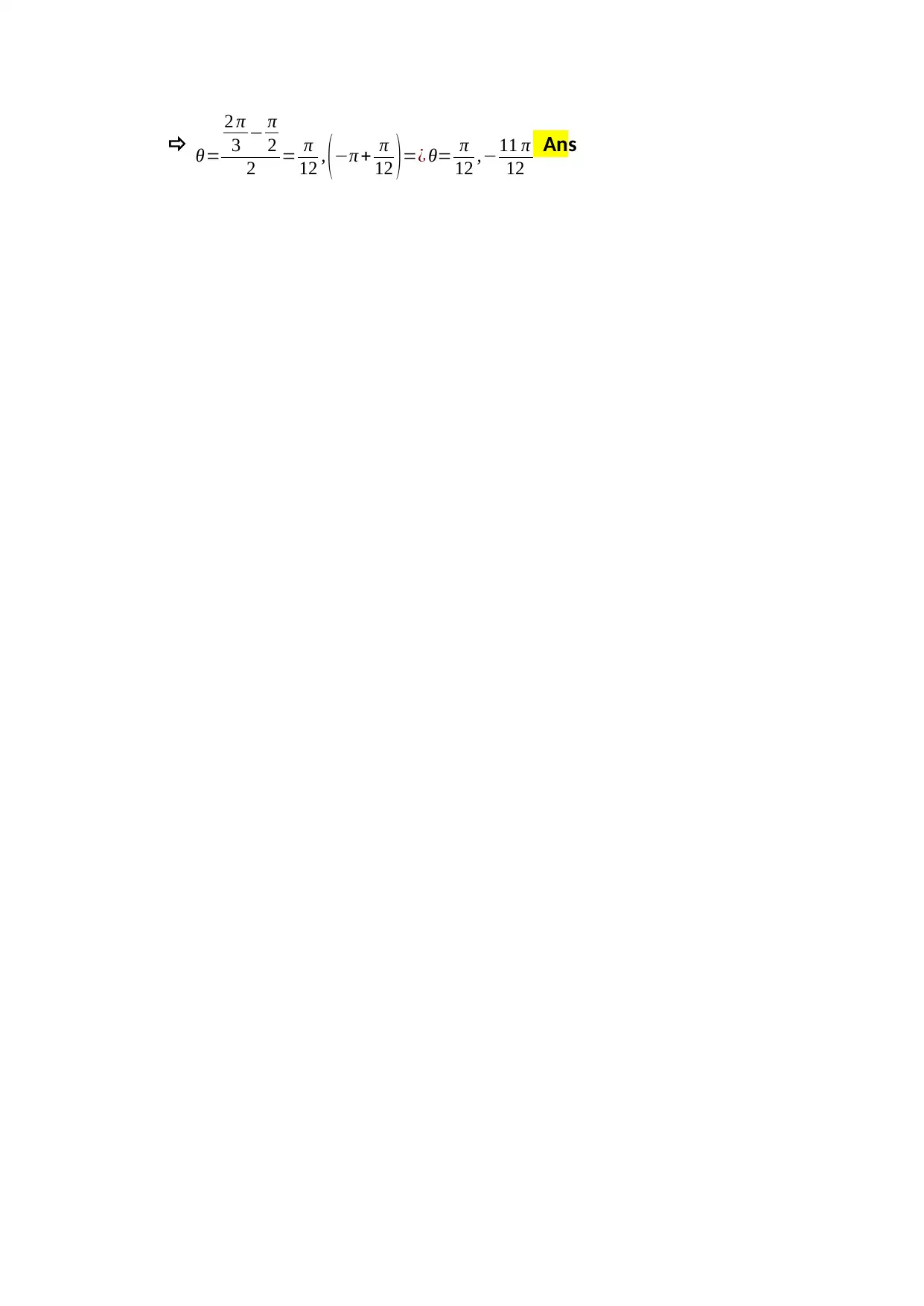
θ=
2 π
3 − π
2
2 = π
12 , (−π + π
12 )=¿ θ= π
12 ,−11 π
12
Ans
2 π
3 − π
2
2 = π
12 , (−π + π
12 )=¿ θ= π
12 ,−11 π
12
Ans
1 out of 6
Related Documents
Your All-in-One AI-Powered Toolkit for Academic Success.
+13062052269
info@desklib.com
Available 24*7 on WhatsApp / Email
![[object Object]](/_next/static/media/star-bottom.7253800d.svg)
Unlock your academic potential
© 2024 | Zucol Services PVT LTD | All rights reserved.




